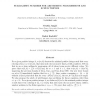Free Online Productivity Tools
i2Speak
i2Symbol
i2OCR
iTex2Img
iWeb2Print
iWeb2Shot
i2Type
iPdf2Split
iPdf2Merge
i2Bopomofo
i2Arabic
i2Style
i2Image
i2PDF
iLatex2Rtf
Sci2ools
ENDM
2007
2007
Sub-Ramsey Numbers for Arithmetic Progressions and Schur Triples
For a given positive integer k, sr(m, k) denotes the minimal positive integer such that every coloring of [n], n ≥ sr(m, k), that uses each color at most k times, yields a rainbow AP(m); that is, an m-term arithmetic progression, all of whose terms receive different colors. We prove that sr(3, k) = 17 8 k + O(1) and, for m > 1 and k > 1, that sr(m, k) = Ω(m2 k), improving the previous bounds of Alon, Caro, and Tuza from 1989. Our new lower bound on sr(m, 2) immediately implies that for n ≤ m2 2 , there exists a mapping φ : [n] → [n] without a fixed point such that for every AP(m) A in [n], the set A ∩ φ(A) is not empty. We also propose the study of sub-Ramsey–type problems for linear equations other than x+y = 2z. For a given positive integer k, we define ss(k) to be the minimal positive integer n such that every coloring of [n], n ≥ ss(k), that uses each color at most k times, yields a rainbow solution to the Schur equation x + y = z. We prove that ss(k) = 5k...
| Added | 13 Dec 2010 |
| Updated | 13 Dec 2010 |
| Type | Journal |
| Year | 2007 |
| Where | ENDM |
| Authors | Jacob Fox, Veselin Jungic, Rados Radoicic |
Comments (0)

